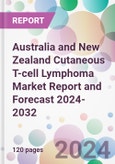Australia and New Zealand Cutaneous T-cell Lymphoma Market Outlook
The Australia and New Zealand cutaneous T-cell lymphoma market size is anticipated to grow at a CAGR of 11.3% during the forecast period of 2024-2032, driven by the increasing prevalence of the condition and the development of advanced treatments.Cutaneous T-cell Lymphoma: Introduction
Cutaneous T-cell lymphoma (CTCL) is a rare type of cancer that originates in T-lymphocytes (a type of white blood cell) and primarily affects the skin. It manifests as patches, plaques, or tumors on the skin, and in advanced stages, can involve lymph nodes, blood, and internal organs. CTCL is characterized by a slow progression, and its symptoms can include itching, red rashes, and, in later stages, larger skin tumors or ulcers. Treatment varies based on the disease stage and includes skin-directed therapies and systemic treatments.Key Trends in the Australia and New Zealand Cutaneous T-cell Lymphoma Market
Growing investment in the development of advanced treatments, including targeted therapies and immunotherapies, offering more effective and less toxic options for patients. A trend towards personalized treatment approaches, utilizing molecular profiling to tailor therapies to individual patient's genetic makeup and disease characteristics.Advances in diagnostic techniques, aiding in the early detection and accurate staging of CTCL, which is critical for effective treatment planning. Efforts to raise awareness about CTCL among healthcare providers and patients, leading to earlier diagnosis and treatment.
Enhanced emphasis on supportive care and quality of life for patients with CTCL, including managing symptoms like itching and pain, and addressing psychological impacts.
Increased collaboration between pharmaceutical companies, research institutions, and healthcare providers, fostering innovation and speeding up the development of new treatments.
Australia and New Zealand Cutaneous T-cell Lymphoma Market Segmentation
Market Breakup by Disease Type
- Mycosis Fungoides (MF)
- Sezary Syndrome (SS)
Market Breakup by Treatment Type
- Radiation therapy
- Stem Cell Transplantation
- Topical Chemotherapy
- Chemotherapy
- Immunotherapy
Market Breakup by Disease Stage
- Early-Stage (Limited) CTCL
- Advanced-Stage (Advanced) CTCL
Market Breakup by End User
- Hospitals
- Specialty Clinics
- Ambulatory Surgical Centres
Market Breakup by Country
- Australia
- New Zealand
Australia and New Zealand Cutaneous T-cell Lymphoma Market Overview
In Australia, the market for Cutaneous T-cell lymphoma (CTCL) treatments is shaped by a comprehensive healthcare system and a focus on specialized care. Specialized Treatment Centers: Growth of specialized dermatology and oncology centers offering advanced treatments for CTCL, ensuring specialized care. Active participation in clinical trials and research initiatives to develop and adopt new and effective treatments for CTCL. Increasing awareness among healthcare professionals and the public, leading to earlier diagnosis and treatment, which is crucial for better prognosis in CTCL. Availability and approval of innovative therapeutic options, including targeted therapies and immunotherapies, providing a broader range of treatment options for patients.In New Zealand, the CTCL market reflects the country's well-structured healthcare system and focus on equitable healthcare access. Emphasis on providing integrated care through collaboration between dermatologists, oncologists, and primary healthcare providers, ensuring comprehensive patient management. Access to advanced pharmaceuticals and treatment options, supported by the country's healthcare policies and regulatory framework. Establishment of support programs and resources for patients, aiding in treatment adherence, patient education, and improving the quality of life. A growing trend towards personalized treatment plans, considering individual patient needs and disease characteristics, to optimize treatment outcomes in CTCL.
Australia and New Zealand Cutaneous T-cell Lymphoma Market: Competitor Landscape
The key features of the market report include patent analysis, grants analysis, clinical trials analysis, funding and investment analysis, partnerships, and collaborations analysis by the leading key players.- Mylan N.V. (now part of Viatris)
- Celgene Corporation (now part of Bristol Myers Squibb)
- Takeda Pharmaceutical Company Limited
- Mundipharma International Limited
- Novartis AG
- Kyowa Kirin Co., Ltd.
- Incyte Corporation
- Bristol Myers Squibb
- Eli Lilly and Company
- Genentech, Inc. (a member of the Roche Group)
- Seattle Genetics, Inc.
- Almirall, S.A.
- Eisai Co., Ltd.
- Karyopharm Therapeutics Inc.
- Leo Pharma A/S
This product will be delivered within 5-7 business days.
Table of Contents
Companies Mentioned
- Mylan N.V. (now part of Viatris)
- Celgene Corporation (now part of Bristol Myers Squibb)
- Takeda Pharmaceutical Company Limited
- Mundipharma International Limited
- Novartis AG
- Kyowa Kirin Co. Ltd. Incyte Corporation
- Bristol Myers Squibb
- Eli Lilly and Company
- Genentech Inc. (a member of the Roche Group)
- Seattle Genetics Inc.
- Almirall
- S.A.
- Eisai Co. Ltd.
- Karyopharm Therapeutics Inc.
- Leo Pharma A/S








